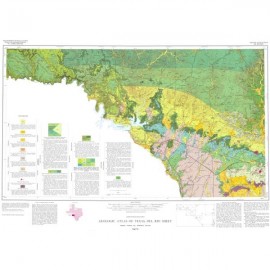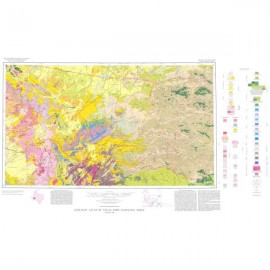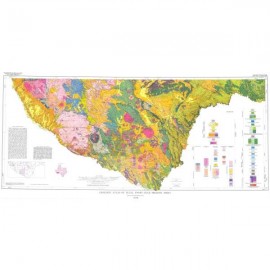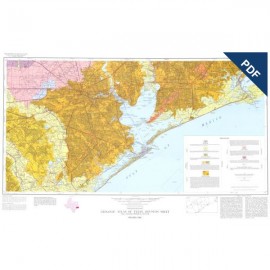Reports of Investigations
-
Books & Reports
- Reports of Investigations
- Guidebooks
- Udden Series
- Geological Circulars
- Down To Earth
- Atlases of Major Oil and Gas Reservoirs
- Texas Memorial Museum Publications
- Environmental Geologic Atlas of the Texas Coastal Zone
- Mineral Resource Circulars
- Other Reports
- Seminars and Workshops
- Handbooks
- Submerged Lands of Texas
- Symposia
- Annual Reports
- Open File Reports
-
Maps & Cross Sections
- Thematic Maps
- Miscellaneous Maps, Charts & Sections
- Geologic Atlas of Texas
- STATEMAP Project Maps
- Geologic Quadrangle Maps
- Cross Sections
- Highway Geology Map
- Energy and Mineral Resource Maps
- Shoreline Change and Other Posters
- Wilcox Group, East Texas, Geological / Hydrological Folios
- Bouguer Gravity Atlas of Texas
- River Basin Regional Studies
- Featured Maps
- Posters
- Teachers & the Public
-
Geological Society Publications
- Gulf Coast Association of Geological Societies
- Alabama Geological Society
- Austin Geological Society
- Corpus Christi Geological Society
- Houston Geological Society
- Lafayette Geological Society
- Mississippi Geological Society
- New Orleans Geological Society
- South Texas Geological Society
- GCS SEPM Publications
- Historic BEG & UT Series
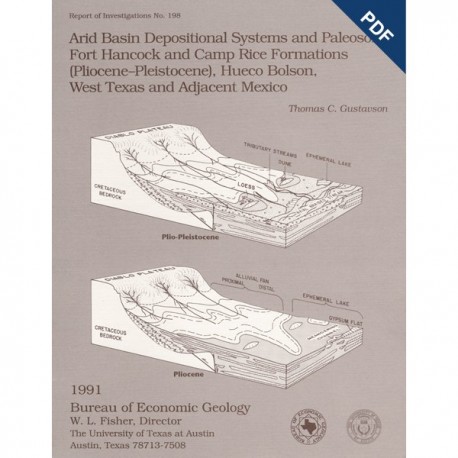
Arid Basin Depositional Systems... Ft. Hancock and Camp Rice FMs., Hueco Bolson...and...Mexico. Digital Download
RI0198D
For a print version: RI0198.
RI0198D. Arid Basin Depositional Systems and Paleosols: Fort Hancock and Camp Rice Formations (Pliocene-Pleistocene), Hueco Bolson, West Texas and Adjacent Mexico, by T. C. Gustavson. 49 p., 29 figs., 3 tables, 1 appendix, 1991. doi.org/10.23867/RI0198D. Downloadable PDF.
To purchase this publication in book format, please order RI0198.
ABSTRACT
The Hueco Bolson is a segment of the Rio Grande Rift that formed as a result of late Tertiary Basin and Range deformation. The upper Tertiary Fort Hancock Formation and the upper Tertiary-Quaternary Camp Rice Formation compose the basin fill except in the deepest (western) parts of the bolson.
Five lithofacies form the Fort Hancock Formation: (I) gravel; (II) sand, sandy mud or sandy silt, and gravel; (III) sand, sandy mud, and sandy silt; (IV) clay and sandy clay; and (V) clay, mud, sandy mud, and gypsum. These lithofacies represent the textural gradation from basin margin to basin center of proximal to transitional to distal alluvial fans (lithofacies I through III) to ephemeral lakes (N) to saline playas 0. In cores from the study area, these samelithofacies compose a 230-m-thick (700-ft) upward-fining sequence. The sequence records the lacustrine expansion that occurred over basin-margin alluvial fans as the basin filled.
The Fort Hancock Formation is separated from the overlying Camp Rice Formation by a regional unconformity. This unconformity records a period of extensive erosion marking the integration of the ancestral southern and northern segments of the Rio Grande about 2.25 Ma ago. Fluvial, lacustrine, and eolian sediments formed above the unconformity as the Camp Rice Formation. Five lithofacies also constitute the Camp Rice Formation: (1) sand and locally derived gravel, deposited by tributaries of the Rio Grande; (2) sand and exotic gravel, derived from north of the study area and deposited by a through-flowing stream (the Rio Grande); (3) sand, deposited as a dune complex; (4) coarse silt and very fine sand, deposited as loess; and (5) clay, sandy clay, and gypsum, deposited in ephemeral lakes with central playas.
Paleoclimatic conditions can be inferred from both buried soils and depositional environments. Numerous Stage I and Stage I1 calcic soils exist in the Fort Hancock and Camp Rice Formations, indicating that while these sediments were being deposited the climate was most likely arid to subhumid. Clayey and muddy facies with locally preserved bedded gypsum, interpreted as ephemeral lake and saline playa deposits, are present in both formations. These depositional environments also suggest an arid to semiarid climate.
Paleovertisols, which formed primarily from repeated episodes of expansion and contraction of lacustrine muds and clays caused by precipitation or flooding and desiccation, are common in outcrops and in cores of smectite-rich clay and mud facies of the Fort Hancock and Camp Rice Formations.
Keywords: alluvial fan, Camp Rice Formation, ephemeral lake, Fort Hancock Formation, geomorphology, Paleocene, paleoclimate, paleosols, Pleistocene, stratigraphy, Vertisols
Citation
Gustavson, T. C., 1991, Arid Basin Depositional Systems and Paleosols: Fort Hancock and Camp Rice Formations (Pliocene-Pleistocene), Hueco Bolson, West Texas and Adjacent Mexico: The University of Texas at Austin, Bureau of Economic Geology, Report of Investigations No. 198, 49 p.

